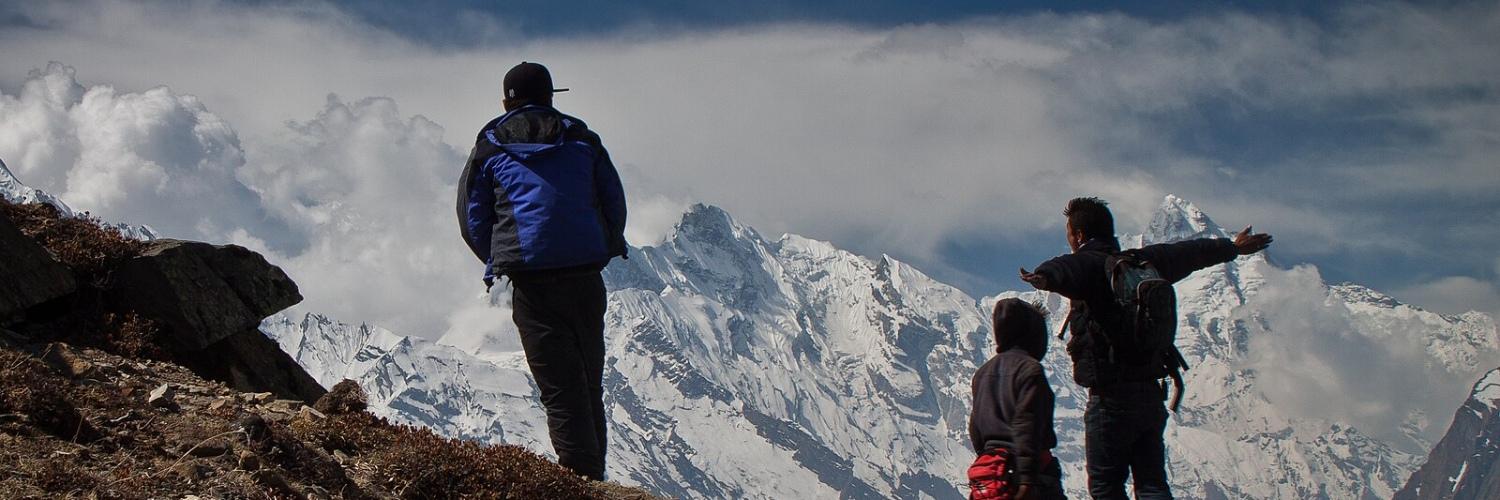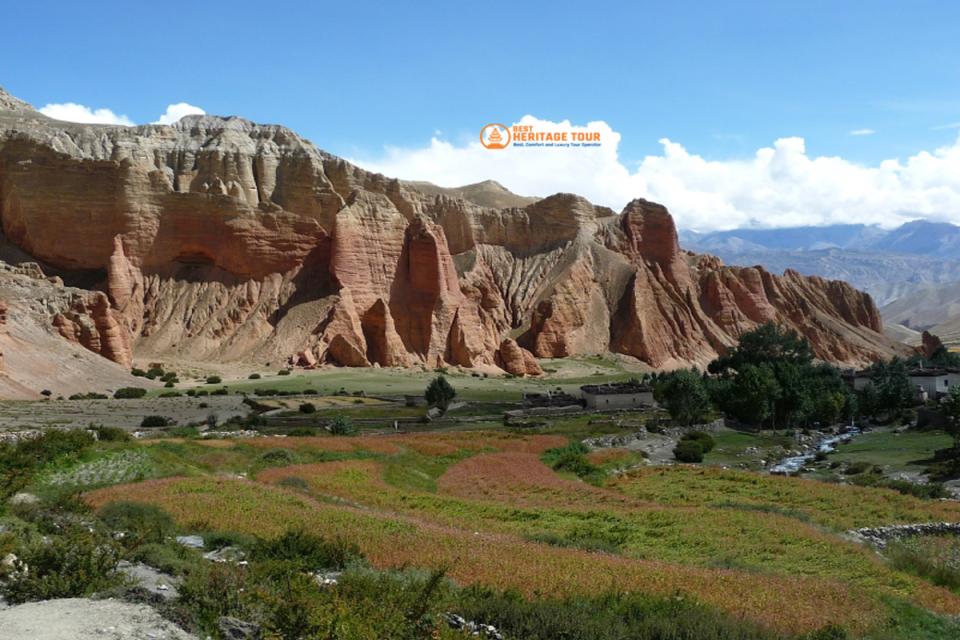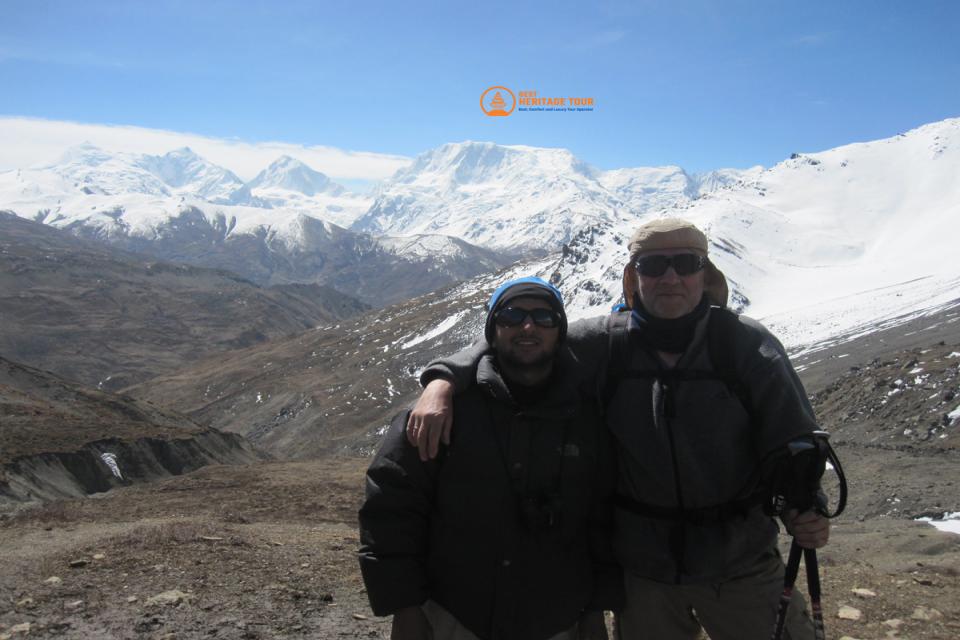When it comes to trekking in Nepal, many adventurers stick to the popular paths - Everest, Annapurna, Langtang. But hidden behind the high Himalayan curtain lie two of Nepal’s most enchanting, lesser-known regions: Nar Phu Valley and Upper Mustang.
Both were once forbidden kingdoms, closed to outsiders until recent decades. Both offer raw landscapes, deeply rooted Tibetan cultures, and journeys that feel more like time travel than tourism. But they’re vastly different in terrain, culture, accessibility, and overall vibe.
So if you’re planning one unforgettable trek - which should you choose: Nar Phu or Upper Mustang?
Let’s explore.
Where Are These Forbidden Kingdoms?
Both Nar Phu Valley and Upper Mustang lie tucked into the northern frontiers of Nepal, yet they offer two strikingly different worlds - one carved by deep gorges and snowfields, the other shaped by wind-sculpted cliffs and high-desert silence.
Nar Phu: Hidden in the Shadows of Annapurna
Secluded beyond the Annapurna Circuit, Nar Phu Valley is a remote Himalayan pocket branching off near Koto (close to Chame). Trekking here feels like stepping back in time - where ancient Tibetan villages, narrow stone paths, and windswept passes define the journey.
-
Region: Northeastern Annapurna region (Manang District)
-
Access Point: Koto (via Annapurna Circuit trail) - only accessible by foot
-
Highlights: Remote stone villages (Nar & Phu), dramatic Kang La Pass (5,320 m), preserved Buddhist culture
-
Opened to Trekkers: 2003 - retains an untouched, wild character
-
Vibe: Rugged, isolated, raw Himalayan experience
Nar Phu is for those who crave remoteness, cultural purity, and a path few dare to follow.
Upper Mustang: Nepal’s Hidden Desert Kingdom
Further west, beyond the towering Annapurna and Dhaulagiri ranges, lies Upper Mustang - a high-altitude desert plateau bordering the Tibetan Plateau. Known as the "Last Forbidden Kingdom," this region was once part of an ancient Himalayan kingdom with its own monarchy and walled capital, Lo Manthang.
-
Region: North of Annapurna/Dhaulagiri (Mustang District)
-
Access Point: Fly or drive to Jomsom, then continue by foot or jeep
-
Highlights: Cliffside cave monasteries, ochre-colored canyons, medieval city of Lo Manthang
-
Opened to Trekkers: 1992 - entry still restricted via expensive permits
-
Vibe: Wide valleys, dry landscapes, spiritual silence, strong Tibetan influence
Upper Mustang is for those drawn to surreal landscapes, cultural mysticism, and a sense of royalty amidst Himalayan deserts.
Quick Comparison Snapshot
|
Feature |
Nar Phu Valley |
Upper Mustang |
|---|---|---|
|
Region |
Manang District, Annapurna Region |
Mustang District, Tibetan Plateau |
|
Accessibility |
Only by trekking via Koto (Chame) |
Flight/road to Jomsom + trekking or jeep |
|
Landscape |
Snowy passes, deep gorges, alpine wild |
Arid desert, caves, wide valleys |
|
Culture |
Remote Tibetan-Buddhist villages |
Ancient kingdom with royal Tibetan heritage |
|
Opened to Trekkers |
2003 |
1992 |
|
Trekking Vibe |
Wild, challenging, raw |
Spiritual, surreal, semi-comfortable |
Cultural Immersion: A Walk Through Living Tibetan Heritage
Both Nar Phu Valley and Upper Mustang are cultural time capsules - but they offer different flavors of immersion. One is a raw, isolated glimpse into mountain life, while the other feels like walking through a royal Tibetan scroll brought to life.
Nar Phu Valley: A Glimpse into an Isolated Way of Life
Hidden high in the Manang district, the tiny villages of Nar, Phu, and Meta remain remarkably untouched by modernity. Life moves to the rhythm of prayer wheels, yak bells, and chants echoing from ancient monasteries perched above craggy cliffs.
-
Village Life: Small, scattered hamlets like Nar and Phu - where the population is low and daily life revolves around yak herding and farming.
-
Language & Culture: Locals speak Tibetan dialects, follow deeply rooted Buddhist traditions, and celebrate mountain deities through rituals unchanged for centuries.
-
Authentic Experience: Very few trekkers make it this far, so cultural encounters are intimate, raw, and unfiltered by tourism.
-
Monasteries: Visit ancient gompas like Tashi Lhakhang - a spiritual haven rarely seen by outsiders.
Nar Phu is not for the casual traveler - it’s for the curious soul seeking a deep, immersive, and genuinely untouched Tibetan experience.
Upper Mustang: Royalty, Ritual, and Living Heritage
Step into Lo Manthang, the walled capital of Upper Mustang, and you’ll feel like you've entered a Himalayan kingdom lost in time. This region blends Tibetan mysticism, medieval architecture, and living traditions into one unforgettable experience.
-
Royal Legacy: The last standing king of Mustang reigned here until 2008, and the spirit of that monarchy still lingers in Lo Manthang’s stone walls and regal courtyards.
-
Cliff Culture: Discover sky caves once used for meditation, burial, and shelter - some over 2,000 years old.
-
Festivals: Time your trek with the famous Tiji Festival, where masked monks perform dances to ward off evil spirits - a ritual spectacle deeply rooted in Bon and Buddhist traditions.
-
Access vs. Authenticity: Though better connected with roads and lodges, the cultural richness of Upper Mustang remains strong and beautifully preserved.
Upper Mustang is a cultural gem for those who seek deep heritage with a touch of comfort - and don’t mind a few fellow travelers along the way.
Quick Cultural Contrast
|
Element |
Nar Phu Valley |
Upper Mustang |
|---|---|---|
|
Type of Culture |
Remote Tibetan Buddhist villages |
Former Tibetan kingdom with royal influence |
|
Number of Villages |
Sparse - Nar, Phu, Meta |
Larger settlements including walled Lo Manthang |
|
Cultural Events |
Subtle, daily traditions |
Major festivals like Tiji |
|
Interaction with Locals |
Intimate, rare, deeply personal |
Rich, structured, accessible |
|
Religious Sites |
Ancient gompas in isolation |
Sky caves, monasteries, royal palaces |
Landscapes: Snowy Gorges or Painted Deserts?
If trekking were like stepping into a movie set, Nar Phu and Upper Mustang would be scenes from two completely different worlds - both breathtaking, yet starkly distinct.
Nar Phu Valley: Rugged, Remote, and Wild
The landscapes of Nar Phu are unapologetically raw. Imagine threading through narrow gorges that feel like they were carved yesterday, crossing icy high-altitude passes like Kang La (5,320 m), and walking past clusters of wild yaks grazing on alpine meadows.
-
Alpine Majesty: Surrounded by towering peaks such as Annapurna II, Himlung Himal, and Kang Guru, the valley feels dramatically hemmed in by snow and stone.
-
Remote Terrain: Expect steep canyons, glacial rivers, and stone trails barely wide enough for a hiker and a yak to pass.
-
Seasonal Beauty: In spring, wildflowers bloom across meadows, adding softness to an otherwise harsh, high-altitude terrain.
-
Adventure Vibe: It’s perfect for trekkers who want solitude, silence, and scenery that’s as powerful as it is untamed.
Nar Phu is raw, elemental, and majestic - ideal for those who find peace in alpine wilderness and aren’t afraid to earn their views.
Upper Mustang: Painted Cliffs and Desert Mystique
Step into Upper Mustang and you're in a different universe - one of silence, color, and space. Think ochre cliffs, wind-sculpted canyons, and endless high plateaus stretching to the Tibetan border.
-
Desert Beauty: The arid terrain is unlike anything else in Nepal - it’s often compared to Ladakh or the Tibetan Plateau.
-
Painted Earth: Mustang's cliffs and canyons glow in hues of red, orange, and beige, especially magical during sunrise and sunset.
-
Hidden Mysteries: The landscape is dotted with ancient sky caves, carved into the cliffs, some dating back over a thousand years.
-
Spiritual Stillness: The vast emptiness carries a haunting beauty - the kind that invites introspection with every step.
If Nar Phu is a cold, wild whisper from the Himalayas, Upper Mustang is a sunlit echo from a forgotten Tibetan kingdom - dry, dramatic, and soul-stirring.
Quick Landscape Contrast
|
Element |
Nar Phu Valley |
Upper Mustang |
|---|---|---|
|
Terrain Type |
Alpine wilderness with snow and rock |
High-altitude desert with painted cliffs |
|
Notable Features |
Snowy peaks, yak pastures, glacial gorges |
Wind-carved canyons, ochre cliffs, sky caves |
|
Color Palette |
Whites, greens, grays (rugged, icy) |
Reds, oranges, browns (desert tones) |
|
Mood |
Wild, cold, solitary |
Mystical, spacious, timeless |
|
Ideal For |
Alpine adventure lovers |
Fans of surreal, desert-like mountain beauty |
Trekking Experience: Rugged Adventure or Cultural Journey?
Choosing between Nar Phu and Upper Mustang isn’t just about landscapes or culture - it’s also about what kind of trekking experience you’re looking for. One pushes your physical limits in raw wilderness; the other offers rich culture with more comfort and accessibility.
Nar Phu Valley: Remote, Raw, and Demanding
Trekking in Nar Phu is not for the faint of heart - and that’s exactly why many love it. Once you leave the Annapurna Circuit at Koto, you step into isolation. There are no roads, no rescue routes, and barely any signs. What you get in return is unmatched solitude and adventure.
-
No Roads, Only Trails: The entire journey is on foot - from forests to high-altitude passes.
-
Basic Teahouses: Accommodations are simple and sparse, with limited menu options. In some cases, you might rely on homestays or camping.
-
Challenging Terrain: High passes like Kang La (5,320 m) demand strong acclimatization and stamina.
-
More Isolation, Less Support: You’ll encounter few trekkers, which enhances the remote feel but means fewer helping hands if you need assistance.
Nar Phu is ideal for trekkers seeking an off-grid, physically intense, and spiritually quiet mountain escape.
Upper Mustang: Easier Trails with Cultural Richness
In contrast, Upper Mustang offers a smoother trekking experience without compromising on mystique. Thanks to road access and better facilities, it’s perfect for those who want to soak in ancient culture without battling high altitudes or extreme terrain.
-
Access Made Easy: Fly to Jomsom or drive part of the way. A jeep can take you directly to Lo Manthang, though hiking is still recommended for immersion.
-
Better Infrastructure: Expect guesthouses, reliable food, and even Wi-Fi in some areas.
-
Gentle Trails: The elevations are still high (3,500-4,200 m), but the trekking paths are more gradual and less punishing than Nar Phu.
-
More Flexibility: Great for older travelers, families, or those short on time.
Upper Mustang caters to those who want cultural depth with physical ease - a trek with soul, not suffering.
Quick Trekking Comparison
|
Element |
Nar Phu Valley |
Upper Mustang |
|---|---|---|
|
Accessibility |
No roads; foot access only |
Fly or drive to Jomsom; jeep possible to Lo |
|
Trekking Infrastructure |
Basic teahouses, limited support |
Guesthouses, better facilities, some road access |
|
Physical Difficulty |
High - long distances, steep passes |
Moderate - easier terrain, less altitude stress |
|
Trek Style |
Wild and isolated |
Comfortable and semi-supported |
|
Ideal For |
Hardcore trekkers, solitude seekers |
Culture lovers, relaxed trekkers, families |
Permits & Costs: What to Expect Before You Trek
Before you lace up your boots, both Nar Phu and Upper Mustang require more than just a love for mountains - they come with restricted area permits and certain trekking regulations. Understanding the permit structure and costs will help you plan better and avoid surprises on the trail.
Nar Phu Valley: Budget-Friendly but Physically Demanding
Though Nar Phu Valley is remote and rugged, it's a bit easier on the wallet when it comes to permits. The region still maintains its "restricted" status, which means solo trekking is not allowed - you’ll need to go through a registered agency with a licensed guide.
-
Restricted Area Permit (RAP):
• USD 100 per week (September-November)
• USD 75 per week (December-August) -
Other Permits:
• ACAP (Annapurna Conservation Area Permit)
• TIMS (Trekkers’ Information Management System) card -
Trekking Rules:
• Trekking independently is not permitted
• A licensed guide and local agency are mandatory
Nar Phu is ideal for those seeking a low-cost, high-adventure trek - more affordable in permit fees, but requiring greater physical effort and logistical planning.
Upper Mustang: Pricier, but Smoother
Upper Mustang is the more expensive of the two, but the trade-off is convenience. The trail is better developed, the terrain less demanding, and the permit process smoother - though the cost reflects its exclusivity.
-
Restricted Area Permit (RAP):
• USD 500 for the first 10 days
• USD 50 per additional day -
Other Permits:
• ACAP required
• TIMS is optional (not mandatory) -
Trekking Rules:
• Must be done with a licensed trekking agency and guide
• No independent treks allowed
Upper Mustang costs more up front, but its accessibility, infrastructure, and cultural highlights make it worth every penny for many travelers.
Permit Comparison Summary
|
Region |
RAP Cost |
Other Permits |
Guide Required |
Independent Trekking |
|---|---|---|---|---|
|
Nar Phu |
$100/week (Sep-Nov), $75/week (off-season) |
ACAP + TIMS |
Yes |
Not allowed |
|
Upper Mustang |
$500/10 days + $50/day after |
ACAP (TIMS optional) |
Yes |
Not allowed |
Best Time to Visit: When Should You Trek These Remote Regions?
Choosing the right season can make or break your experience in the Himalayas. Both Nar Phu Valley and Upper Mustang offer stunning trekking opportunities, but the ideal months differ slightly due to geography and climate.
Nar Phu Valley: Clear Skies and Alpine Beauty
The best time to trek Nar Phu is during the pre-monsoon spring (March-May) and post-monsoon autumn (September–November) seasons. During these months, the skies are clear, the mountain views are pristine, and the high passes like Kang La (5,320 m) are mostly snow-free.
-
Best Months: March-May and September-November
-
Avoid:
• Winter (Dec-Feb) - Harsh cold and heavy snow can block passes
• Monsoon (June-August) - Trails become slippery and risky
If you're aiming for solitude and dramatic alpine scenery, spring and autumn deliver the most rewarding conditions in Nar Phu.
Upper Mustang: A Rare Monsoon-Friendly Trek
One of Upper Mustang’s greatest advantages is its location in the Himalayan rain shadow, which keeps the region dry even during Nepal’s monsoon season. That makes it a prime destination from May through November, including the typically off-limits summer months.
-
Best Months: May-November
-
Yes, You Can Trek in Summer!
• Mustang's arid climate allows safe trekking even during the June-August monsoon -
Less Ideal:
• Winter months (December-February) can still be quite cold, especially in Lo Manthang
Whether you're planning around your vacation schedule or just want to escape the rain elsewhere in Nepal, Upper Mustang is a top choice for monsoon trekking.
Seasonal Summary
|
Region |
Best Trekking Months |
Monsoon-Friendly? |
Winter Trek Possible? |
|---|---|---|---|
|
Nar Phu |
March-May, Sept-Nov |
No |
No |
|
Upper Mustang |
May-November (incl. monsoon) |
Yes |
Limited, very cold |
Who Should Trek Where? Matching the Trail to Your Travel Style
Both Nar Phu Valley and Upper Mustang offer unforgettable journeys - but they cater to very different types of trekkers. Your ideal trek depends on what you value most: rugged wilderness, ancient culture, comfort, or isolation.
Choose Nar Phu Valley if you’re a rugged adventurer at heart
This trek is for the bold and curious - those who don’t mind roughing it for a more authentic and off-grid experience. The trails are quieter, the culture is untouched, and the raw beauty of the high Himalayas surrounds you every step of the way.
-
You crave solitude, raw nature, and unfiltered cultural experiences
-
You’re comfortable with basic accommodations, minimal infrastructure, and physically demanding trails
-
You want to avoid commercial routes and go where few trekkers dare to tread
If you consider yourself a mountain purist, Nar Phu offers that untamed adventure you’ve been looking for.
Choose Upper Mustang if you're a cultural explorer seeking comfort
Upper Mustang offers easier logistics, more developed infrastructure, and rich Tibetan heritage in spades. From the walled city of Lo Manthang to the vibrant Tiji Festival, this region is a living museum of Himalayan royalty, religion, and architecture.
-
You’re fascinated by Tibetan-Buddhist culture, desert landscapes, and ancient cave dwellings
-
You prefer moderate trekking difficulty with better lodging and the option to drive parts of the route
-
You want a trek that’s remote yet comfortable, rich in history, and ideal for photographers and storytellers
If you want to immerse yourself in cultural depth without the extreme challenges of high-altitude isolation, Upper Mustang delivers beautifully.
Quick Trekker Type Match
|
Trekker Type |
Best Choice |
|---|---|
|
Seeks solitude & rugged trekking |
Nar Phu Valley |
|
Loves Tibetan culture & comfort |
Upper Mustang |
|
Wants remote, raw experience |
Nar Phu Valley |
|
Enjoys festivals & history |
Upper Mustang |
|
Prioritizes budget |
Nar Phu Valley |
|
Prefers accessibility |
Upper Mustang |
Final Thoughts: Two Kingdoms, One Choice
Both Nar Phu and Upper Mustang are rare gems - each with its own magic, hardships, and rewards. Whichever you choose, you’ll walk paths that most of the world will never see and step into cultures that have resisted time itself.
Still can’t decide? Let the experts guide you.
Plan Your Trek with Best Heritage Tour
We specialize in custom treks to both Nar Phu Valley and Upper Mustang, led by experienced guides who understand the terrain, culture, and soul of these forbidden kingdoms.
Visit: www.bestheritagetour.com
Email: info@bestheritagetour.com / bestheritagetour@gmail.com
Phone / WhatsApp / Viber: +977-9851149197
Office: Thamel Marg, Kathmandu, Nepal
Author: Best Heraitage Tour
Date: 5th August, 2025



